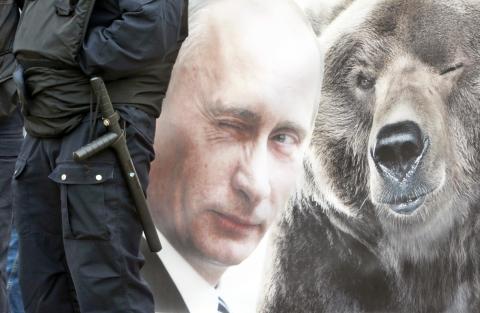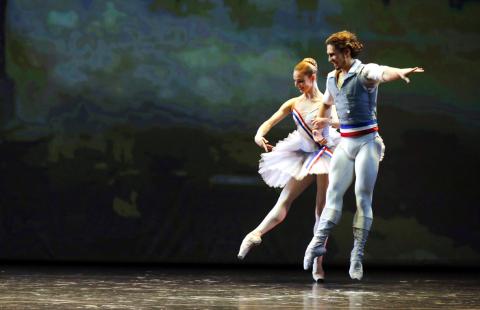After the media, the oligarchs and the opposition, Vladimir Putin’s Russia is turning up the heat on the arts, with a “blasphemous” opera, a raunchy teen dance show and an “insulting” Hollywood film all taking fire.
Claiming a mission to protect the sensibilities of the Russian people, the Kremlin and the Orthodox Church are leaning on artists to imbue their creations with greater morality.
The attacks go over well in a society steeped in the conservative anti-Western values preached by Putin, who has been isolated by the West over the Ukraine crisis.

Photo: AP
Since the Russian strongman burst onto the center stage in 1999, several groups have been called to heel, from journalists to business magnates and human rights activists.Now the authorities’ sights are trained on the cultural sector, with the government keen to promote a new approach.
“The time has come to formulate our own vision of ourselves as heirs to Russia’s great, unique civilization,” Culture Minister Vladimir Medinsky said, explaining the recent banning of the release of the Hollywood thriller Child 44, about a serial killer operating in Joseph Stalin’s Russia.
The minister accused the film, which stars Vincent Cassel and Gary Oldman, of the “distortion of historical facts” and depicting Soviet Army officers as “blood-thirsty ghouls”.

Photo: EPA
A few weeks before that, the object of popular wrath was the head of the state-funded Novosibirsk State Opera and Ballet Theater.
Boris Mezdrich was fired for sensationally depicting Jesus Christ as a character in an erotic movie in his production of Richard Wagner’s opera Tannhaeuser, triggering an outcry from spectators and the church.
Other productions or works to cause a furore this year included a mural by a street artist in the eastern city of Perm showing the first man in space, Russia’s Yuri Gagarin, as a “Jesus of science,” being crucified.
The artist faces up to one year in prison. An exhibition by Canadian artist Frank Rodick of pictures of his dead mother also caused scandal, with church authorities in the Baltic Sea exclave of Kaliningrad calling for “limits on what is tolerable in art”.
In another vein entirely, three teens filmed twerking in front of a World War II memorial were sentenced to up to 15 days imprisonment.The sentencing came after a video of girls in leotards twerking at a dance school in the southwestern city of Orenburg went viral, prompting the Investigative Committee to launch an indecency probe.
‘WE MUST PROTECT OURSELVES’
Artists whose work is deemed “blasphemous” also face having the book thrown at them.
In July 2013, lawmakers adopted legislation making it a crime to insult believers’ feelings, punishable by up to three years in prison. From a dozen cases in 2013 the number of prosecutions under the law rose to around 50 last year.
For film director Sergei Selyanov, producer of animated films inspired by Russian folklore, the “censorship aims to fill the void left by the (loss of an) historic national identity, which was buried together with the USSR”.
The current concept of Russian nationhood, said Konstantin Remchukov, chief editor of the Nezavisimaya Gazeta daily, is based on “two obligatory elements, patriotism and anti-Westernism.” Hostility to the West has flourished among both the elite and ordinary Russians, who have been fed a staple diet of anti-Western fare by the media over the Ukraine crisis and the legalization of gay marriage in several countries.
A troupe of actors from the western city of Pskov recently came out swinging — against a play in which they themselves were cast.
One of the actors, Sergei Popkov, took issue with the character of a dwarf who becomes king, seeing in it an “allusion to our president.”
“We must protect ourselves...against the West which wants to destroy everything here,” he said, demanding a return to Soviet-style cultural censorship.
World War II, or the Great Patriotic War as Russians call it, is a prime example of a sacrosanct subject, where self-censorship is exercised. Bookshops in Moscow recently pulled their copies of Art Spiegelman’s Pulitzer prize-winning graphic novel about a Holocaust survivor, Maus, because it features a swastika on the cover.
With parliament having adopted a law in December banning Nazi propaganda the stores decided to play safe rather than risk prosecution.

Seven hundred job applications. One interview. Marco Mascaro arrived in Taiwan last year with a PhD in engineering physics and years of experience at a European research center. He thought his Gold Card would guarantee him a foothold in Taiwan’s job market. “It’s marketed as if Taiwan really needs you,” the 33-year-old Italian says. “The reality is that companies here don’t really need us.” The Employment Gold Card was designed to fix Taiwan’s labor shortage by offering foreign professionals a combined resident visa and open work permit valid for three years. But for many, like Mascaro, the welcome mat ends at the door. A

Last week gave us the droll little comedy of People’s Republic of China’s (PRC) consul general in Osaka posting a threat on X in response to Japanese Prime Minister Sanae Takaichi saying to the Diet that a Chinese attack on Taiwan may be an “existential threat” to Japan. That would allow Japanese Self Defence Forces to respond militarily. The PRC representative then said that if a “filthy neck sticks itself in uninvited, we will cut it off without a moment’s hesitation. Are you prepared for that?” This was widely, and probably deliberately, construed as a threat to behead Takaichi, though it

If China attacks, will Taiwanese be willing to fight? Analysts of certain types obsess over questions like this, especially military analysts and those with an ax to grind as to whether Taiwan is worth defending, or should be cut loose to appease Beijing. Fellow columnist Michael Turton in “Notes from Central Taiwan: Willing to fight for the homeland” (Nov. 6, page 12) provides a superb analysis of this topic, how it is used and manipulated to political ends and what the underlying data shows. The problem is that most analysis is centered around polling data, which as Turton observes, “many of these

Since Cheng Li-wun (鄭麗文) was elected Chinese Nationalist Party (KMT) chair on Oct. 18, she has become a polarizing figure. Her supporters see her as a firebrand critic of the ruling Democratic Progressive Party (DPP), while others, including some in her own party, have charged that she is Chinese President Xi Jinping’s (習近平) preferred candidate and that her election was possibly supported by the Chinese Communist Party’s (CPP) unit for political warfare and international influence, the “united front.” Indeed, Xi quickly congratulated Cheng upon her election. The 55-year-old former lawmaker and ex-talk show host, who was sworn in on Nov.